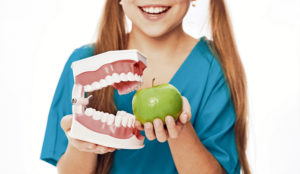 Most kids would agree, snacks are great, but what are these snacks and how frequent is the grazing happening? For example, Takis, Cheetos, candy and anything with simple carbohydrates would be poor options. When it is time for snacks, set a schedule such as, after school instead of grazing throughout the day. Yes, oral hygiene and dental check-ups are important, but let’s focus on nutrition and prevention this time.
Most kids would agree, snacks are great, but what are these snacks and how frequent is the grazing happening? For example, Takis, Cheetos, candy and anything with simple carbohydrates would be poor options. When it is time for snacks, set a schedule such as, after school instead of grazing throughout the day. Yes, oral hygiene and dental check-ups are important, but let’s focus on nutrition and prevention this time.
Dental caries (aka cavities or tooth decay) is the most common chronic disease in children. What is dental caries in basic terms? Imagine a teeter-totter with healthy teeth/gums on one end and cavities (disease) on the other end. On the healthy side: good oral hygiene, good nutrition, dental check-ups, and fluoride. On the cavity side: poor oral hygiene, unhealthy diet, avoiding the dentist, and more. This a dynamic process that hinges on demineralization (loss of minerals) and remineralization (gain of minerals) of the teeth. Teeth only have so many minerals, and if enough are removed, then the result is a hole (cavity).
Nutrition is a key player influencing the teeter-totter one way or the other. There are three main components of nutrition we’ll focus on: sugar, frequency and acid. There are microorganisms everywhere, and our mouths are no exception. These bugs are factories — in goes sugar and out goes acid. Have you ever done the hardboiled egg in vinegar experiment? Vinegar is acidic and reacts with minerals in the eggshell (calcium carbonate). If enough time has passed, the eggshell will be completely dissolved. In this analogy, the minerals in teeth (calcium phosphate) can be compared to the eggshell. The vinegar can be compared to the acid that bacteria produce from metabolizing sugar in addition to the acid we consume from foods or drinks. High frequency of sugar and acid such as snacking on candy or sipping on soda throughout the day would be like soaking the hardboiled egg in the vinegar over and over again. Sugar, frequency and acid stand out when considering nutrition’s importance with healthy teeth.
It’s getting down to crunch time. In order to keep the teeter-totter leaning toward the healthy direction, the quality and frequency of what is consumed matters. To reiterate practical tips: schedule set snack times, avoid simple/refined carbohydrates and rinse with water after snacking can all help. Give your teeth a break in between meals by keeping the snacking and sipping to a “reaso-nibble” level; your teeth will thank you.


